The Intel Core i9-9980XE CPU Review: Refresh Until it Hertz
by Ian Cutress on November 13, 2018 9:00 AM ESTHEDT Performance: System Tests
Our System Test section focuses significantly on real-world testing, user experience, with a slight nod to throughput. In this section we cover application loading time, image processing, simple scientific physics, emulation, neural simulation, optimized compute, and 3D model development, with a combination of readily available and custom software. For some of these tests, the bigger suites such as PCMark do cover them (we publish those values in our office section), although multiple perspectives is always beneficial. In all our tests we will explain in-depth what is being tested, and how we are testing.
All of our benchmark results can also be found in our benchmark engine, Bench.
Application Load: GIMP 2.10.4
One of the most important aspects about user experience and workflow is how fast does a system respond. A good test of this is to see how long it takes for an application to load. Most applications these days, when on an SSD, load fairly instantly, however some office tools require asset pre-loading before being available. Most operating systems employ caching as well, so when certain software is loaded repeatedly (web browser, office tools), then can be initialized much quicker.
In our last suite, we tested how long it took to load a large PDF in Adobe Acrobat. Unfortunately this test was a nightmare to program for, and didn’t transfer over to Win10 RS3 easily. In the meantime we discovered an application that can automate this test, and we put it up against GIMP, a popular free open-source online photo editing tool, and the major alternative to Adobe Photoshop. We set it to load a large 50MB design template, and perform the load 10 times with 10 seconds in-between each. Due to caching, the first 3-5 results are often slower than the rest, and time to cache can be inconsistent, we take the average of the last five results to show CPU processing on cached loading.

Loading software is usually an achilles heel of multi-core processors based on the lower frequency. The 9980XE pushes above and beyond the 7980XE in this regard, given it has better turbo performance across the board.
FCAT: Image Processing
The FCAT software was developed to help detect microstuttering, dropped frames, and run frames in graphics benchmarks when two accelerators were paired together to render a scene. Due to game engines and graphics drivers, not all GPU combinations performed ideally, which led to this software fixing colors to each rendered frame and dynamic raw recording of the data using a video capture device.
The FCAT software takes that recorded video, which in our case is 90 seconds of a 1440p run of Rise of the Tomb Raider, and processes that color data into frame time data so the system can plot an ‘observed’ frame rate, and correlate that to the power consumption of the accelerators. This test, by virtue of how quickly it was put together, is single threaded. We run the process and report the time to completion.
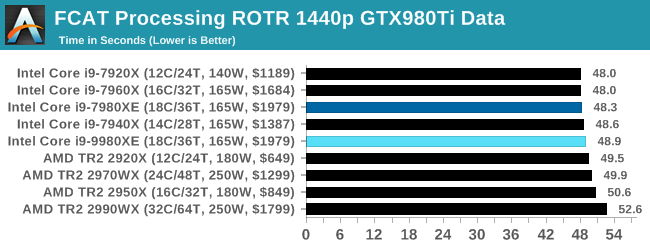
Despite the 9980XE having a higher frequency than the 7980XE, they both fall in the same region as all these HEDT processors seems to be trending towards 48 seconds. For context, the 5.0 GHz Core i9-9900K scores 44.7 seconds, another 8% or so faster.
3D Particle Movement v2.1: Brownian Motion
Our 3DPM test is a custom built benchmark designed to simulate six different particle movement algorithms of points in a 3D space. The algorithms were developed as part of my PhD., and while ultimately perform best on a GPU, provide a good idea on how instruction streams are interpreted by different microarchitectures.
A key part of the algorithms is the random number generation – we use relatively fast generation which ends up implementing dependency chains in the code. The upgrade over the naïve first version of this code solved for false sharing in the caches, a major bottleneck. We are also looking at AVX2 and AVX512 versions of this benchmark for future reviews.
For this test, we run a stock particle set over the six algorithms for 20 seconds apiece, with 10 second pauses, and report the total rate of particle movement, in millions of operations (movements) per second. We have a non-AVX version and an AVX version, with the latter implementing AVX512 and AVX2 where possible.
3DPM v2.1 can be downloaded from our server: 3DPMv2.1.rar (13.0 MB)
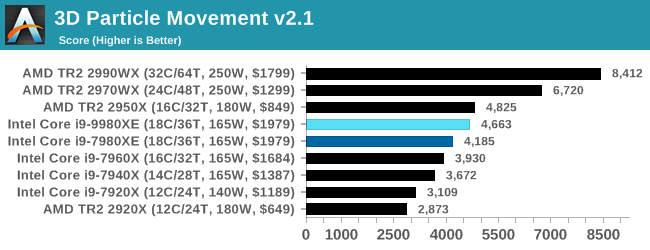
Without any AVX code, our 3DPM test shows that with fewer cores, AMD's 16-core Threadripper actually beats both of the 7980XE and 9980XE. The higher core count AMD parts blitz the field.

When we add AVX2 / AVX512, the Intel HEDT systems go above and beyond. This is the benefit of hand-tuned AVX512 code. Interestingly the 9980XE scores about the same as the 7980XE - I have a feeling that the AVX512 turbo tables for both chips are identical.
Dolphin 5.0: Console Emulation
One of the popular requested tests in our suite is to do with console emulation. Being able to pick up a game from an older system and run it as expected depends on the overhead of the emulator: it takes a significantly more powerful x86 system to be able to accurately emulate an older non-x86 console, especially if code for that console was made to abuse certain physical bugs in the hardware.
For our test, we use the popular Dolphin emulation software, and run a compute project through it to determine how close to a standard console system our processors can emulate. In this test, a Nintendo Wii would take around 1050 seconds.
The latest version of Dolphin can be downloaded from https://dolphin-emu.org/
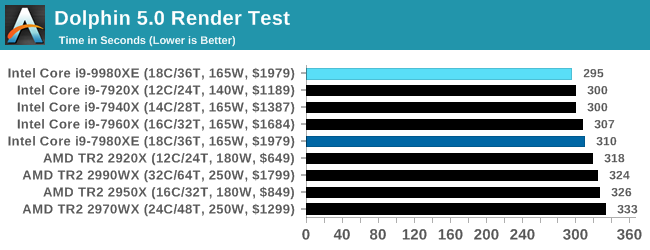
Dolphin enjoys single thread frequency, so at 4.5 GHz we see the 9980XE getting a small bump over the 7980XE.
DigiCortex 1.20: Sea Slug Brain Simulation
This benchmark was originally designed for simulation and visualization of neuron and synapse activity, as is commonly found in the brain. The software comes with a variety of benchmark modes, and we take the small benchmark which runs a 32k neuron / 1.8B synapse simulation, equivalent to a Sea Slug.
Example of a 2.1B neuron simulation
We report the results as the ability to simulate the data as a fraction of real-time, so anything above a ‘one’ is suitable for real-time work. Out of the two modes, a ‘non-firing’ mode which is DRAM heavy and a ‘firing’ mode which has CPU work, we choose the latter. Despite this, the benchmark is still affected by DRAM speed a fair amount.
DigiCortex can be downloaded from http://www.digicortex.net/
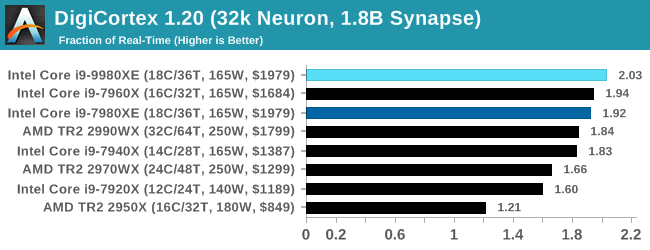
DigiCortex requires a good memory subsystem as well as cores and frequency. We get a small bump for the new 9980XE here.
y-Cruncher v0.7.6: Microarchitecture Optimized Compute
I’ve known about y-Cruncher for a while, as a tool to help compute various mathematical constants, but it wasn’t until I began talking with its developer, Alex Yee, a researcher from NWU and now software optimization developer, that I realized that he has optimized the software like crazy to get the best performance. Naturally, any simulation that can take 20+ days can benefit from a 1% performance increase! Alex started y-cruncher as a high-school project, but it is now at a state where Alex is keeping it up to date to take advantage of the latest instruction sets before they are even made available in hardware.
For our test we run y-cruncher v0.7.6 through all the different optimized variants of the binary, single threaded and multi-threaded, including the AVX-512 optimized binaries. The test is to calculate 250m digits of Pi, and we use the single threaded and multi-threaded versions of this test.
Users can download y-cruncher from Alex’s website: http://www.numberworld.org/y-cruncher/
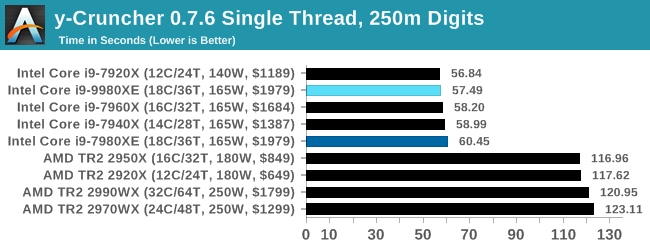
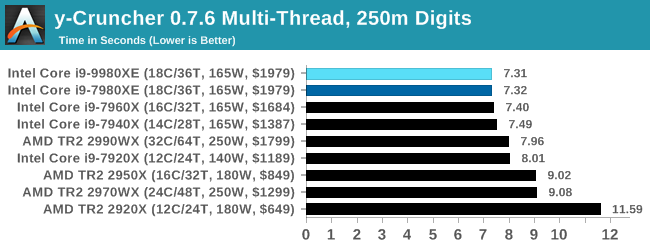
With another one of our AVX2/AVX512 tests, the Skylake-X parts win in both single thread and multi-threads.
Agisoft Photoscan 1.3.3: 2D Image to 3D Model Conversion
One of the ISVs that we have worked with for a number of years is Agisoft, who develop software called PhotoScan that transforms a number of 2D images into a 3D model. This is an important tool in model development and archiving, and relies on a number of single threaded and multi-threaded algorithms to go from one side of the computation to the other.
In our test, we take v1.3.3 of the software with a good sized data set of 84 x 18 megapixel photos and push it through a reasonably fast variant of the algorithms, but is still more stringent than our 2017 test. We report the total time to complete the process.
Agisoft’s Photoscan website can be found here: http://www.agisoft.com/
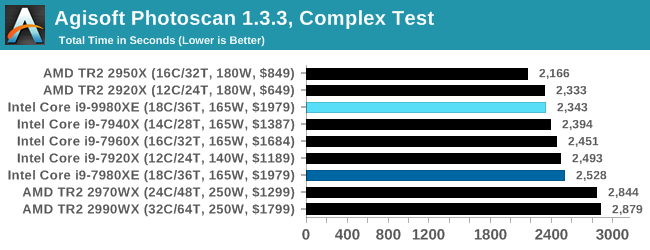
Photoscan is a mix of parallel compute and single threaded work, and the 9980XE does give another 7-8% performance over the 7980XE. The AMD dual-die TR2 parts still have the edge, however.


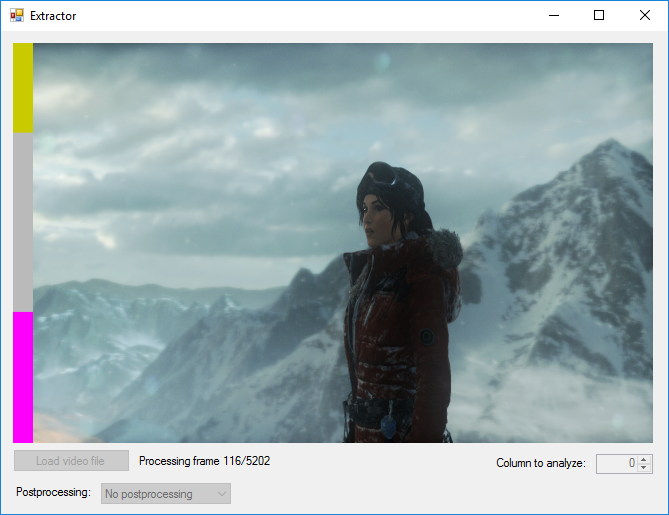










143 Comments
View All Comments
MisterAnon - Wednesday, November 14, 2018 - link
PNC is not right at all, he's completely wrong. Unless your job requires you to walk around and type at the same time using a laptop is a net loss of producitivity for zero gain. At a professional workplace anyone who thinks that way would definitely be fired. If you're going to be in the same room for 8 hours a day doing real work, it makes sense to have a desktop with dual monitors. You will be faster, more efficient, more productive, and more comfortable. Powerful desktops are more useful today than ever before due to the complexity of modern demands.TheinsanegamerN - Wednesday, November 14, 2018 - link
What is your source for gamers being the primary consumers of HDET?imaheadcase - Tuesday, November 13, 2018 - link
Well of course for programming its ok. That is like saying you moved from a desktop to a phone for typing. It requires nothing to type hardly for power. lol That pretty much as always been the case.bji - Tuesday, November 13, 2018 - link
I think you are implying programming is not a CPU intensive task? Certainly it can be low intensity for small projects, but trust me it can also use as much CPU as you can possibly throw at it. When you have a project that requires compiling thousands or tens of thousands of files to build it ... the workload scales fairly linearly with the number of cores, up to some fuzzy limit mostly set by memory bandwidth.twtech - Thursday, November 15, 2018 - link
I also work in software development (games), and my experience has been completely the opposite. I've actually only known one programmer who preferred to work on a laptop - he bought a really high-end Clevo DTR and brought it in to work.I do have a laptop at my desk - I brought in a Surface Book 2 - but I mostly just use it for taking notes. I don't code on it.
Unless you're going to be moving around all the time, I don't know why you'd prefer to look at one small screen and type on a sub-par laptop keyboard if there's the choice of something better readily available. And two 27" screens is pretty much the minimum baseline - I have 3x 30" here at home.
:And then of course there's the CPU - if you're working on a really small codebase, it might not matter. But if it's a big codebase, with C++, you want to have a lot of cores to be able to distribute the compiling load. That's why I'm really interested in the forthcoming W3175x - high clocks plus 28 cores on a monolithic chip sounds like a winning combination for code compiling. High end for a laptop is what, 6 cores now?
Laibalion - Saturday, November 17, 2018 - link
What utter nonsense. I'be been working on large and complex c++ codebases (2M+ LOC for a single product) for over a decade, and compute power is an absolute necessity to work efficiently. Compile times such beast scales linearly (if done properly), so no one wants a shit mobile cpu for their workstation.HStewart - Tuesday, November 13, 2018 - link
Mobile has been this way for decade - I got a new job working at home and everyone is on laptops - todays laptop are as powerful as most desks - work has quad core notebook and this is my 2nd notebook and first one was from nine years ago. Desktops were not used in my previous job. Notebook mean you can be mobile - for me that is when I go to home office which is not often - but also bring notebook to meeting and such.I am development C++ and .net primary.
Desktop are literary dinosaurs now becoming part of history.
bji - Tuesday, November 13, 2018 - link
You are not working on big enough projects. For your projects, a laptop may be sufficient; but for larger projects, there is certainly a wide chasm of difference between the capabilities of a laptop and those of a workstation class developer system.MisterAnon - Wednesday, November 14, 2018 - link
Today's laptops are not as powerful as desktops. They use slow mobile processors, and overheat easily due to thermals. If you're working from home you're still sitting in a chair all day, meaning you don't need a laptop. If your company fired you and hired someone who uses a desktop with dual monitors, they would get significantly more work done for them per dollar.Atari2600 - Tuesday, November 13, 2018 - link
I wouldn't call them very "professional" when they are sacrificing 50+% productivity for mobility.Anyone serious about work in a serious work environment* has a workstation/desktop and at least 2 of UHD/4k monitors. Anything else is just kidding yourself thinking you are productive.